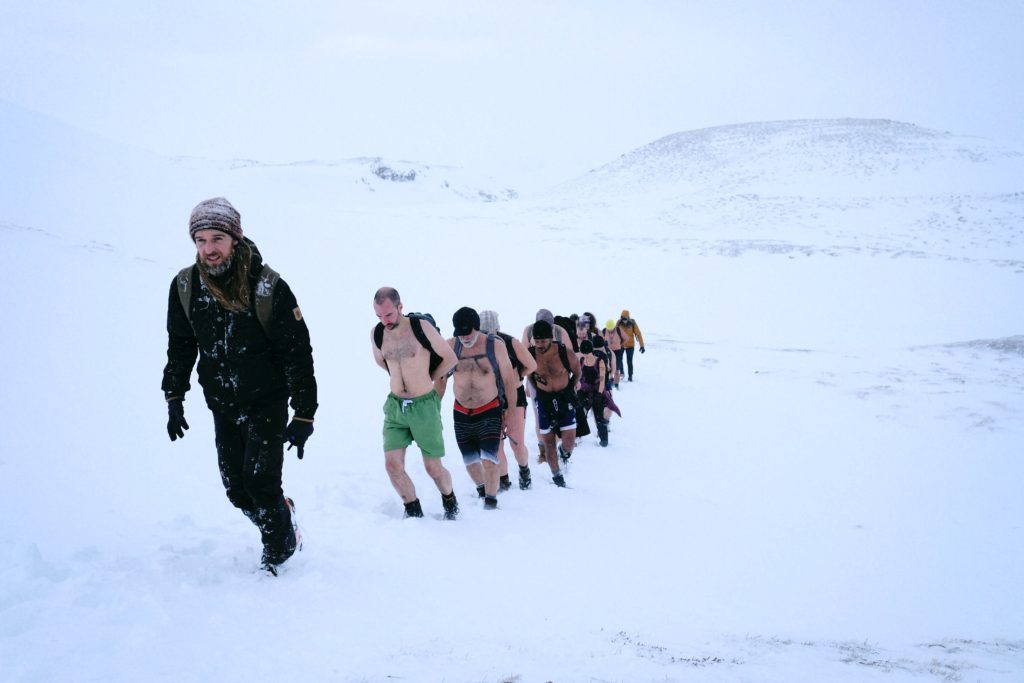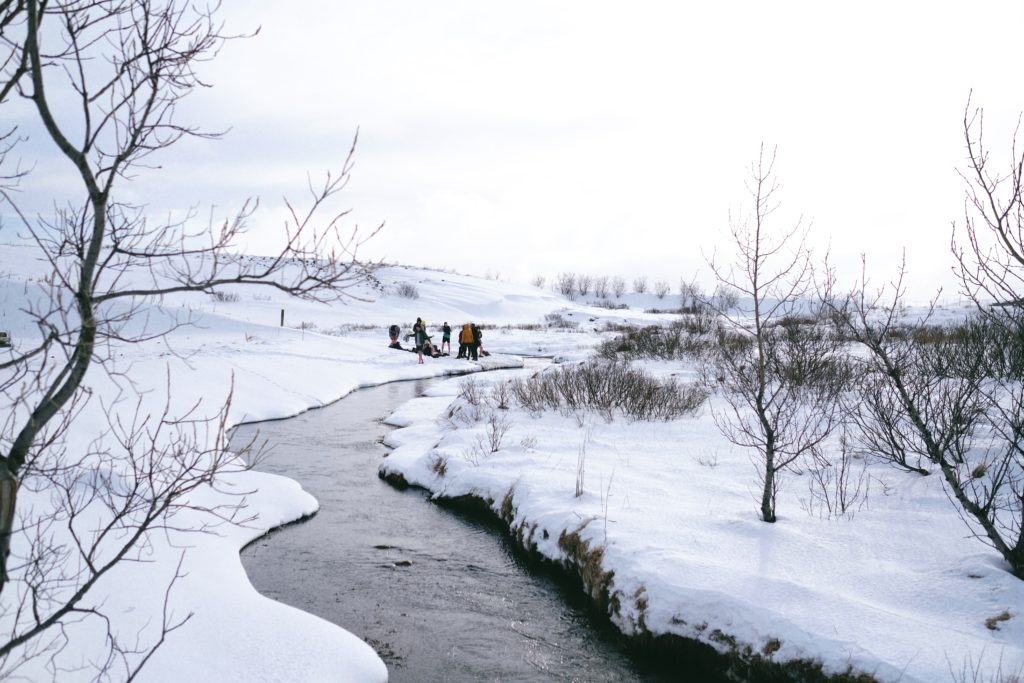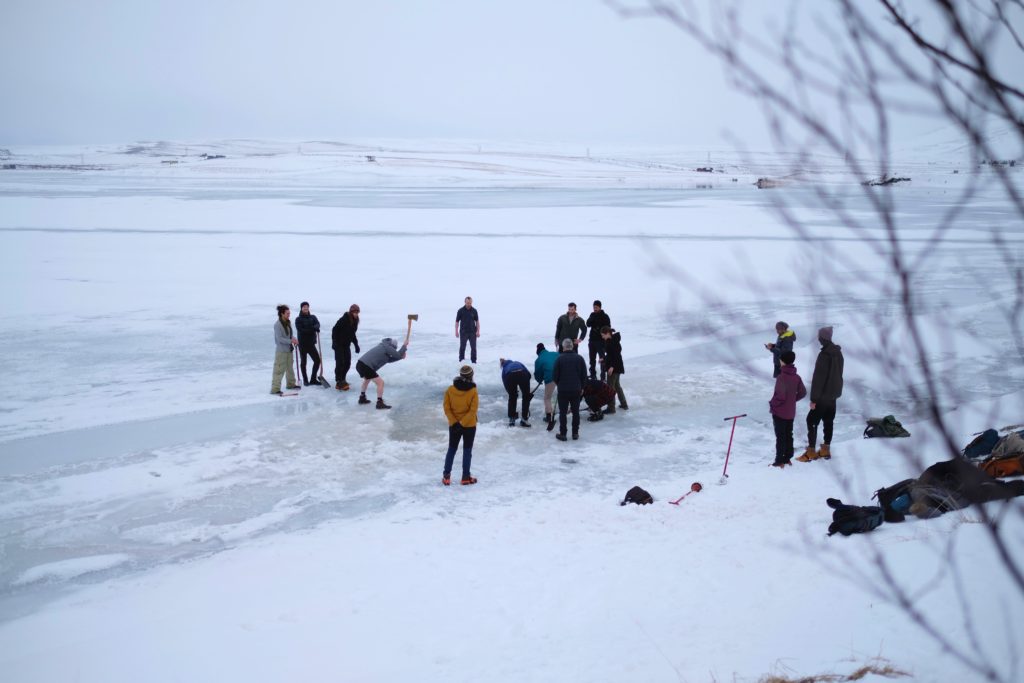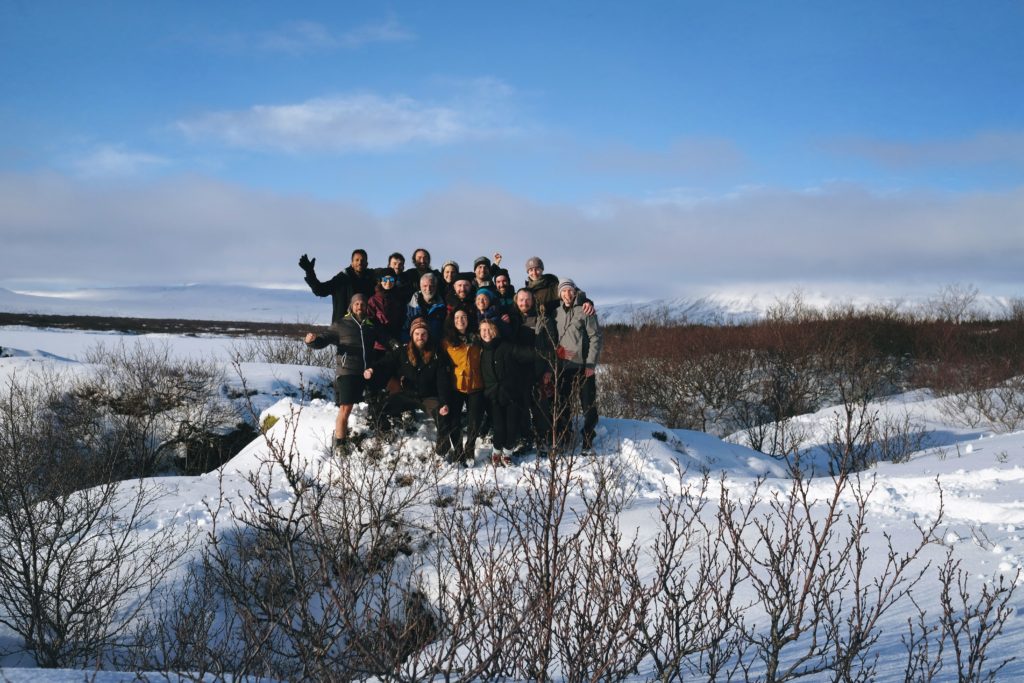Highlights from my intense week at the Iceland Into The Wild Within Expedition
In this article, I will walk you through some of the most powerful moments and lessons that stuck with me from the Into the Wild Within Iceland Expedition, which ran from Feb 27 to March 5, 2020.
The expedition was centered around the Wim Hof Method (WHM), and it also brought in a mix of other practices like yoga, meditation and therapeutic sound healing.
It was one of the wildest and most intense weeks of my life, and I boiled it down into the following seven sections (which you can jump to as you like using the links below):
- Background, and learning to love the wind
- Stuck in a van
- Rattled: epic hike through Reykjadalur Valley
- Ice dip revelation: focus on yourself
- Sweat lodge
- Sit on a frozen lake, in a swimsuit, meditate for 20 minutes; then ice dip
- Four big takeaways
The Into The Wild Within Winter Expedition was a blast, and such a unique way to experience the magic of Iceland. I hope this post inspires you to explore the world in unique ways, embrace the elements — especially the cold! — and push yourself to learn how to use stress and trauma to grow stronger.
Background: learning to love the wind
A couple months ago, in early January 2020, I got my first solid taste of cold exposure at the Wim Hof Winter Expedition Poland, a five-day workshop that teaches the WHM with breathing exercises, ice baths and various forms of meditation.
The experience — which you can read all about in The Iceman Cometh — served as a launching pad for me in two respects: 1) it kicked off my big move and big break travel adventure in Europe; and 2) it would leave me hungry for more cold exposure.
So when I learned one of my instructors — Joren de Bruin, whose calm, inspiring and holistic approach to the WHM practice, along with his masterful skill at guiding breathing sessions, really resonated with me — was leading another WHM winter expedition in Iceland in late February, it seemed like great timing and a fun way to build on all the great stuff I learned in Poland; so I went ahead and signed up.
The Into The Wild Within Iceland Expedition, which Joren runs with his partner Elena Stavropoulou, also aligned with one of my 2020 Goals: Make a big move; take a few months off to travel and explore random stuff that seems interesting; see where the wind takes you.
Ah, the wind. The brutal, unforgiving, icy, skin-cutting, bone-chilling, soul-piercing, soul-crushing, soul-charging wind.
In this case the wind took me on an epic hike in my swimsuit through a snowstorm.
It took me into a sweat lodge, with glowing goblin lava rocks, engulfed in darkness.
It took me to a frozen lake, on which we meditated, and in which we carved out a swimming pool.
It took me deep within my self, body and mind.
It opened new doors, taught me valuable lessons, and connected me with an inspiring group of 16 other cold-craving crazies.
I am grateful for the wind, my good friend, and every other element that made this adventure in Iceland one of the most intense and eye-opening weeks of my life.
It all started with the first of many big challenges, before we even arrived at the campgrounds.
Stuck in a van
On Day 1, as we drove out from Reykjavík to the Úlfljótsvatn Scout Center — a summer camp site about an hour away that would serve as our homebase for the week (think bunk beds, hiking trails, ropes courses, rivers and lakes) — Mother Nature welcomed us with strong winds, snow, and icy roads.
Soon enough our vans started getting stuck, requiring everyone to jump out into the storm and push them free. We’d then jump back inside, drive for a bit, get stuck again, and hop out again for another push. Rinse and repeat. What would have normally taken probably 20 minutes under normal conditions took more than an hour.
The snail’s pace combined with zero visibility and the fact that the storm wasn’t about to let up over the next few hours led our instructor to make the smart decision to call it quits and return to Reykjavík for the night.
We were in such a jam, though, that we needed the police to help get the vans unstuck and back to the city safely.
The rescue squad couldn’t give an estimated time of arrival, since there were likely many other similar cases that night, so we all had to sit tight in the vans and be patient. I was mentally preparing myself to hunker down for the rest of the night — it wouldn’t have been my first time sleeping in a van! — but fortunately the police arrived in what seemed like an hour or so.
We got back to the city safely and bunked up in a hostel. Despite the adversity, everyone in our group kept it cool the whole time, understanding that this stuff happens.
Obviously I think we all would have preferred to have not spent our first night together pushing vans and slipping on icy roads, but in a way, the rocky start served our group well.
The adversity quickly established a trust and camaraderie that we built on over the increasingly intense days that followed.
Rattled: epic hike through Reykjadalur Valley

The afternoon of our first full day at camp we set off to hike an area called Reykjadalur Valley, which was about a 30-45 minute drive from our campgrounds.
When we arrived at the trailhead, Mother Nature welcomed us once again with some extreme wind and snow. The conditions were so intense that we kept our warm clothes on to start the hike.
After about 30 minutes of warm hiking, we arrived at a clearing, stripped down and hiked the rest of the way – I’d say about an hour and a half — in just our swimsuits.
I was wearing waterproof hiking boots with microspikes attached, warm socks and running shorts. In my backpack I had my beanie, gloves, hiking pants, baselayer, sweater, down jacket, outer shell jacket, towel, almonds, protein bar and water bottle.
The temperature was probably about -2 degrees Celsius, not counting an unrelenting windchill. I’d never been exposed to the cold like that, and it was way more difficult than the swimsuit hike I did with the Wim Hof Winter Expedition in Poland.
We walked in a single file line, and the wind seemed to be cutting at my face and chest the whole way. It took an immense effort to stay focused on my breath and in control of my body under those brutal conditions.
At the same time, I was in awe of the scenery that surrounded us: steep cliffs, waterfalls, rivers, rock formations, sloping whites, blues and grays of snow ice and rock.
Other hikers on the trail, bundled up like sane people, would gawk at us as we passed by trudging silently through the snow.
One guy asked us, “What did you do? You are not in prison?” like we were all being punished for something.
I felt good and focused most of the way; however with hilarious comments like the one above, breathtaking scenery, intense conditions, and a group of 16 new friends alongside me, my mind easily wandered and got distracted during many patches of the hike.
I found myself thinking about how my fellow hikers were doing and envisioning different scenarios for what was coming next. Was everyone else struggling as much as I was? What if something bad happened and we had to turn back? Would we be jumping in an icy creek at the end of this hike?
All that questioning and wondering was using up valuable mental energy that my body desperately needed to stay warm, composed and in control.
As the distracted thoughts continued, my mind spun further and further away from my body and breath. When we arrived at our destination — a natural hot springs! — I completely lost my focus and my body started shivering uncontrollably.
My teeth chattered, my jaw tensed, and I could barely open my backpack to sort through my warm clothes. I thought it was too soon for me to get in the hot water, so I fumbled around with my clothes and needed help from the instructors to get my clothes on, and then to get them off again when I was ready to get in a few minutes later.
I was a mess; a cold, bumbling, shivering mess.
But as soon as I was in the hot springs everything got better. I warmed up, stopped shivering and slowly came back to my senses. By that time the wind and snow had died down and everything was beautifully calm around us as we soaked in the beautiful steaming creek.
We relaxed for a while, and then got dressed to check out a nearby waterfall before starting the hour-long trek down the mountain.
Afterwards, riding back in the vans, I felt exhausted, rattled and truly humbled by Mother Nature.
I was amazed at how the elements — the icy wind and snow — traumatized me, tearing my mind away from my body and breath.
I also felt a tremendous level of respect for our group: everyone pushed through and made it back safely. It was one of the most challenging hikes I’ve ever done — mentally, emotionally and physically.
At the end of the day I felt completely spent, even rattled, and I hadn’t even taken an ice dip yet.
Ice dip revelation: focus on yourself

A couple days after the epic hike, while taking an ice dip in a small creek near our camp, I had a breakthrough.
It was a clear and slightly windy morning, and while I was warming up and prepping to step in the cold running water, Joren pulled me over to the side for a quick chat.
He told me to not think about anyone else during this ice dip, and to only focus on myself. I guess he could tell how distracted and mentally disconnected I get.
I agreed, and decided it might help to keep my eyes closed for the full four minutes I was in the water.

Joren’s message stuck with me afterwards, and it helped me see the door I needed to go through to maintain focus in the traumatic cold and better control my wandering mind.
I was spending so much energy thinking about our group — what they were doing to prepare for the ice dip, how they were responding to the cold water, wondering if they needed help, worrying if I was fitting in, trying to help make them happy and comfortable — that I wasn’t able to focus on myself and my own response to the cold.
This is an example of why these winter expeditions and cold exposure exercises are about more than just learning how to handle ice baths and crazy hikes: the extreme conditions reveal core elements and inefficiencies in how you deal with stress, and they can show you new paths to get stronger, healthier and better — especially in tough environments.
In my case, thinking about others is a great thing, and it’s a characteristic that I’m proud of. It’s served me and others extremely well over the years, and it’s something I’ve worked hard at developing in relationships, with friends and family, at work, on teams, everywhere.
However, I won’t be able to help others if I’m bumbling, shivering and spazzing out under stress and trauma — I need to learn how to take care of myself first.
That was my big “aha moment” revelation. It seems pretty obvious, and simple, but I needed the stress of the cold, and some great coaching, to help me see it.
Sweat lodge

After a few days of extreme cold, we shifted gears to extreme heat, and entered a sweat lodge.
Admittedly, I didn’t know much about sweat lodges to begin with, other than they were hot, and that somebody died in one in Sedona years ago. I pictured it as a mix of hot yoga and a sauna — I was way off.
The sweat lodge was essentially a squat mud hut built into the side of the earth, with one small door at about kneecap level. The whole group crawled inside, one by one, sitting cross-legged in a small circle along the hut’s wall, surrounding a pile of rocks in the center.
The sweat lodge session consisted of four rounds, with each round featuring a fresh set of fire-hot, orange, glowing rocks added to the pile in the center. Thus the heat inside the hut built up round by round.
During each round the door to the hut was shut after the fresh set of hot rocks were in place in the center. The guide then would lead the group in chants, while pouring water onto the stones, releasing powerful bursts of steam and heat that filled the room and filled your soul.
It got completely black in the hut, and the only thing I could see was the glowing rocks in the center. It was a weird, intense, sensory trip that took me on a rollercoaster of a journey.
I was seeing colors, going mentally blank, thinking about nothing at all — not even thinking about thinking about nothing! — rubbing mud from the ground onto my face and legs for a layer of protection from the steaming stones less than a foot away.
We drank cold water in between rounds to refresh ourselves, and after the third round I took a breather outside and cooled off for a minute or so.
In the fourth and final round it got extremely hot in there. One of the last rocks that was added had the face and features of a goblin — it was looking directly at me.
Side note: I love getting to these weird places in my head where rocks and natural elements develop faces and interesting features. It usually happens on big hikes from fatigue- and altitude-derived delusions, and I start seeing things in the shadows of rocks and in the patterns on trees. I’ve seen panda bears, dogs’ faces, birds in the shadows, and it always makes me smile. I’m fine. Totally normal.
This time though, I wasn’t smiling at the orange goblin rock in front of me.
The hot air was burning the back of my throat with every breath. I was dripping sweat, drooling and ended up on the ground in a fetal position, chanting, sweating and completely disconnected from my mind and body — everything was just hot and black.
Finally the fourth round was over and we all filtered out, one by one, each person pausing to touch our foreheads to the cold ground for a quick prayer.
The cold air and light wind outside felt amazing. We stood around an open fire nearby as we all came back to reality. I went off to the side and lied in the snow for a bit. It was dusk and everything around the fire and up in the sky was a soft blue and white.
I felt calm, centered, cleansed, warm, relaxed and exhausted.
Sit on a frozen lake, in a swimsuit, meditate for 20 minutes; then ice dip

If the stuck vans, epic ice hike, profound ice dip, and mind-altering sweat lodge weren’t enough, we would be challenged to an even deeper level on the penultimate day of the trip.
The big lake near our camp was frozen under two layers of ice, with a light layer of fresh snow on top. So we spent part of our morning chopping through the ice, carving out a nice ice bath pool at the edge of the lake.
Then we received our challenge: strip down to swimwear, sit down on the frozen lake, meditate there for 20 minutes, then take a dip in the freshly carved ice bath right after.
I couldn’t believe what we were being asked to do, and I felt a daunting, heavy load building in my head as I prepared to meditate.
However, I used this challenge as a way to bring together and practice the profound lessons I had learned earlier in the week.
I focused on my breath, kept calm and held my eyes closed throughout the whole meditation.
I dove within my self, concentrated on my breath, and imagined a huge fireball burning deep in my chest and gut. I fanned the fireball’s flames with each breath, and I used each exhale and gust of icy wind to distribute the raging heat through my body, warming up my frozen feet, numb fingers, tense shoulders and shivering jaw.
Shockingly, the 20 minutes flew by — it honestly felt like five, maybe 10 minutes max.
After the meditation session was over, we all got up, did a quick brief warm-up to center ourselves, and then we calmly got into the ice bath, which was only a few feet away.
I moved slowly, got in the water, kept my eyes closed and felt great for the full three minutes I was in there. Then I got out calmly and went off to the side, focused on myself and did my own warm up routine, with air squats and some brown fat activation breathing exercises (this was the first time brown fat activation actually worked for me — each of these deep breathing rounds sent a surge of warm energy down through my body).
Walking back to our camp I felt in control and invigorated, with boosted confidence in my ability to handle the stress and trauma of the cold, with a centered and focused mind.

Four big takeaways
Building on the profound ice dip revelation I described earlier, here are four of the big lessons I learned from this expedition:
- Carve out time to focus on yourself. Caring for others is great, and you want to build yourself into the strongest platform possible; to provide the strongest connection and best support for others as possible. That means you need to be able to flip the switch between focusing on others to focusing on yourself like an icy ninja. Domesticate your wandering, thinking mind that’s consumed by the outside world and all that comes with it, and dedicate a portion of your time — solid, non-negotiable, prioritized block(s) of your day — to drop in to the inside world, your self.
- Paraphrasing Joren here, with some additional elaboration: Every stressful, traumatic, daunting challenge is an opportunity to find new doors in your mind. They open up pathways for learning, healing, strength and growth. They show you places inside you that you didn’t know existed. They help you decode your senses, emotions and subconscious. There are many ways to get there, and these extreme challenges — the ones that make you truly feel alive — are one of them.
- Be patient and kind with yourself, like you’re your own great friend. You’re doing better than you realize in those stressful moments. Release yourself from unnecessary mental pressure and the stress of expectations.
- Remember to thank yourself. “Thank you, Adam” popped in my head at some point in this journey, and it stuck. It was like my body was telling my mind thank you for taking it easy, thank you for giving us this time, this shock, this space, this adventure.
And thank you to Joren, Elena and our great group for making the Iceland Into The Wild Within Expedition such a fun, powerful and profound experience.

All photos are from the Iceland Into The Wild Within Expedition, led by Joren de Bruin and Elena Stavropoulou, and taken by Clara Eneqvist.
